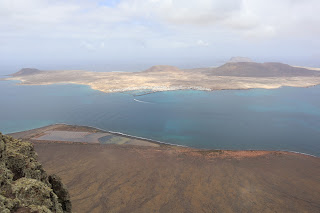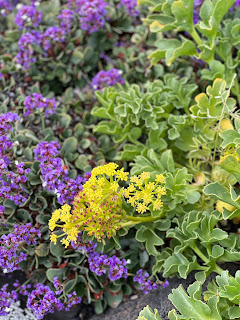Our first stop of the day was at Our Lady of Sorrows Church. The festival of Virgen de los Volcanes began in 1780 when a procession carrying the image of Our Lady of Dolores (Sorrows) miraculously ended a lava flow threatening to reach the village of Tinajo. The cross in the bottom right picture marks the spot where the lava flow stopped.
The next stop was Timanfaya National Park. The park covers 12,600 acres and has 100 volcanoes and 300 craters. It looks quite barren, but there is a lot of plant and animal life there (small though they may be). And the people have figured out how to grow in this volcanic soil.
The greatest recorded eruptions in the Canary Islands occurred between 1730 and 1736 in the area that is now the national park. The island endured six years of fissure eruptions that formed the Montañas del Fuego, and produced lava flows that reached the western coast, destroying the villages of Maretas and Santa Catalina, along with the most fertile valleys and estates on the island. The island's last eruption during 1824 produced a much smaller lava flow that reached the southwest coast.
Lanzarote has a subtropical desert climate, and its inhabitants have adapted their farming to be successful in such a harsh environment. They dig holes so the plants are below grade, and build rock walls to protect the fragile plants from the trade winds. They have also discovered that the volcanic sand helps to moderate temperatures and retain what little moisture is available.
Mirador del Rio is the best viewpoint on the island, on Famara Cliff. You can look out over the northern coastline and the island's oldest salt plains (no longer in operation). This vista was designed by local artist Cesar Manrique in 1973, and sits at an elevation of 1,630 feet above sea level.
Manrique had enormous influence on the development of Lanzarote. He even implemented a white with green, brown or blue trim color scheme for all new buildings to suggest “coolness and tranquility.” The country is very concerned with conservation, and with limits on building heights so as not to obstruct views of their natural setting.


































Comments
Post a Comment